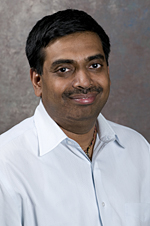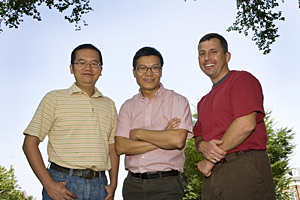
- Rozovsky wins prestigious NSF Early Career Award
- UD students meet alumni, experience 'closing bell' at NYSE
- Newark Police seek assistance in identifying suspects in robbery
- Rivlin says bipartisan budget action, stronger budget rules key to reversing debt
- Stink bugs shouldn't pose problem until late summer
- Gao to honor Placido Domingo in Washington performance
- Adopt-A-Highway project keeps Lewes road clean
- WVUD's Radiothon fundraiser runs April 1-10
- W.D. Snodgrass Symposium to honor Pulitzer winner
- New guide helps cancer patients manage symptoms
- UD in the News, March 25, 2011
- For the Record, March 25, 2011
- Public opinion expert discusses world views of U.S. in Global Agenda series
- Congressional delegation, dean laud Center for Community Research and Service program
- Center for Political Communication sets symposium on politics, entertainment
- Students work to raise funds, awareness of domestic violence
- Equestrian team wins regional championship in Western riding
- Markell, Harker stress importance of agriculture to Delaware's economy
- Carol A. Ammon MBA Case Competition winners announced
- Prof presents blood-clotting studies at Gordon Research Conference
- Sexual Assault Awareness Month events, programs announced
- Stay connected with Sea Grant, CEOE e-newsletter
- A message to UD regarding the tragedy in Japan
- More News >>
- March 31-May 14: REP stages Neil Simon's 'The Good Doctor'
- April 2: Newark plans annual 'wine and dine'
- April 5: Expert perspective on U.S. health care
- April 5: Comedian Ace Guillen to visit Scrounge
- April 6, May 4: School of Nursing sponsors research lecture series
- April 6-May 4: Confucius Institute presents Chinese Film Series on Wednesdays
- April 6: IPCC's Pachauri to discuss sustainable development in DENIN Dialogue Series
- April 7: 'WVUDstock' radiothon concert announced
- April 8: English Language Institute presents 'Arts in Translation'
- April 9: Green and Healthy Living Expo planned at The Bob
- April 9: Center for Political Communication to host Onion editor
- April 10: Alumni Easter Egg-stravaganza planned
- April 11: CDS session to focus on visual assistive technologies
- April 12: T.J. Stiles to speak at UDLA annual dinner
- April 15, 16: Annual UD push lawnmower tune-up scheduled
- April 15, 16: Master Players series presents iMusic 4, China Magpie
- April 15, 16: Delaware Symphony, UD chorus to perform Mahler work
- April 18: Former NFL Coach Bill Cowher featured in UD Speaks
- April 21-24: Sesame Street Live brings Elmo and friends to The Bob
- April 30: Save the date for Ag Day 2011 at UD
- April 30: Symposium to consider 'Frontiers at the Chemistry-Biology Interface'
- April 30-May 1: Relay for Life set at Delaware Field House
- May 4: Delaware Membrane Protein Symposium announced
- May 5: Northwestern University's Leon Keer to deliver Kerr lecture
- May 7: Women's volleyball team to host second annual Spring Fling
- Through May 3: SPPA announces speakers for 10th annual lecture series
- Through May 4: Global Agenda sees U.S. through others' eyes; World Bank president to speak
- Through May 4: 'Research on Race, Ethnicity, Culture' topic of series
- Through May 9: Black American Studies announces lecture series
- Through May 11: 'Challenges in Jewish Culture' lecture series announced
- Through May 11: Area Studies research featured in speaker series
- Through June 5: 'Andy Warhol: Behind the Camera' on view in Old College Gallery
- Through July 15: 'Bodyscapes' on view at Mechanical Hall Gallery
- More What's Happening >>
- UD calendar >>
- Middle States evaluation team on campus April 5
- Phipps named HR Liaison of the Quarter
- Senior wins iPad for participating in assessment study
- April 19: Procurement Services schedules information sessions
- UD Bookstore announces spring break hours
- HealthyU Wellness Program encourages employees to 'Step into Spring'
- April 8-29: Faculty roundtable series considers student engagement
- GRE is changing; learn more at April 15 info session
- April 30: UD Evening with Blue Rocks set for employees
- Morris Library to be open 24/7 during final exams
- More Campus FYI >>
12:04 p.m., Sept. 1, 2009----Five University of Delaware faculty members have received a $1,064,500 grant from the National Science Foundation to conduct research on multiscale modeling of turbulent clouds on petascale computers. Two scientists from a collaborating institution, the National Center for Atmospheric Research (NCAR), will receive a separate award of $300,000 for the same project.
The grant is the first award UD has received from NSF's Accelerating Discovery in Science and Engineering through Petascale Simulations and Analysis (PetaApps) program. The award was made with American Recovery and Reinvestment Act funds at NSF and is coordinated by NSF's Office of Cyberinfrastructure and Division of Atmospheric Sciences.
The three-year collaborative research project will be led by Lian-Ping Wang, professor in the Department of Mechanical Engineering, with a joint appointment in the College of Earth, Ocean, and Environment, and Wojciech W. Grabowski, senior scientist in the Mesoscale and Microscale Meteorology Division at NCAR.
Clouds play an essential role in the weather, the hydrological cycle, and the earth's climate system. Cloud microphysics, which includes the processes by which condensation particles form, grow, and transform, is a source of tremendous uncertainty in numerical atmospheric models because of the wide range of spatial and temporal scales involved and because of the nonlinear and multi-scale couplings among cloud microphysics, latent heating, small-scale turbulence dynamics, and larger scales of motion affected by density stratification and the Earth's rotation.
“Since modeling the entire range of scales from sub-centimeter to global will never be possible, the development of novel theoretical and computational approaches is one way to move forward,” Grabowski explains. “Beyond theoretical challenges, there is also a significant technical challenge related to efficient computation using contemporary and future computer architectures.”
The proposed simulations are extremely computation-intensive. The group will re-design and optimize their simulation codes to explore multi-level parallelism on next-generation heterogeneous supercomputers. Their goal on the computing end will be to achieve a petaflop speed (10 to the 15th power floating point operations per second).
“Since petascale computing is on the horizon, our hybrid approach can be realized and fully explored to address open questions that have challenged atmospheric scientists for years,” Wang says. “We will develop cloud microphysics parameterization for coarser resolution computational models. This will benefit weather and climate modeling from short-term storm-scale forecasts to longer term climate change.”
Co-principal investigators include Guang R. Gao, Distinguished Professor in the Department of Electrical and Computer Engineering; Chandra Kambhamettu, associate professor in the Department of Computer and Information Sciences; Xiaoming Li, assistant professor in the Department of Electrical and Computer Engineering; Louis Rossi, associate professor in the Department of Mathematical Sciences; and Andrzej A. Wyszogrodzki, scientist in the Research Application Laboratory at NCAR.
The group will make use of the state-of-the-art parallel computers at NCAR. In addition, Gao, an expert in modern computer architecture, and Li, an expert in parallel programming and performance optimization, will study the computing challenges -- for example, scalability and performance portability -- involved in the realization of such a large-scale and complex scientific simulation.
“We are building two systems at UD capable of achieving petascale performance, and we plan to leverage them to test various algorithms and optimization options in the parallel implementation of our application codes,” Li says.
Numerical algorithms are the bridge between differential equations governing physical processes and their computer solutions. Rossi, whose research focuses on numerical methods, will examine existing codes developed by Wang and Grabowski to improve their accuracy, efficiency, and robustness.
Because the proposed simulations will generate a large amount of data, managing and interpreting the data is another challenge. Kambhamettu, who specializes in motion and image analysis, will develop interactive visualization tools to elucidate interactions between discrete cloud droplets as well as between a droplet and its local fluid environment.
The new project builds on a collaboration that Wang and Grabowski initiated in 2001 with NSF grants totaling more than $1 million. The two have been studying how air turbulence influences collision-coalescence of cloud droplets, a key process leading to precipitation formation. Their joint work has attracted attention from the international cloud physics community and has led to more than 15 papers in journals covering atmospheric sciences as well as fluid mechanics. Since 2003, Wang has been a regular visiting scientist to NCAR, and in 2005 he was named an NCAR Faculty Fellow.
UD joined the University Corporation for Atmospheric Research in 2007. UCAR is a non-profit consortium of major research universities in North America serving as a hub for research, education, and public outreach in the atmospheric and Earth sciences.
“This new petascale computing project will enhance UD's visibility and stature as a UCAR member university,” says Michael Chajes, dean of the College of Engineering, “and it fits well with our plan to expand our expertise and physical infrastructure in the areas of IT and advanced computing.”
Article by Diane Kukich




